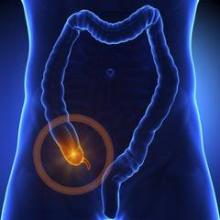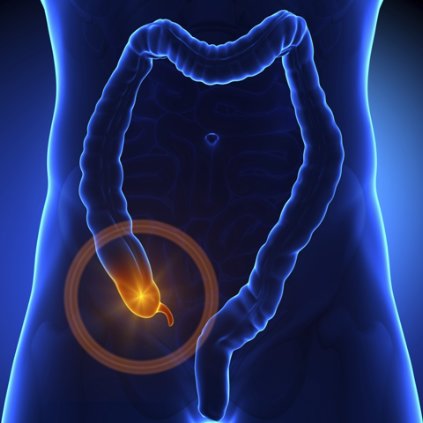User login
Enteral contrast did not augment the accuracy of computed tomography in appendectomy patients, compared with intravenous contrast CT alone, according to a large multihospital study published in Annals of Surgery.
"Enteral contrast should be eliminated in IV-enhanced CT scans performed for suspected appendicitis," said Dr. Frederick Drake at the University of Washington Medical Center in Seattle and his associates. "We conclude that IV contrast alone is sufficient for the diagnosis of appendicitis in a wide variety of hospitals, outside of tertiary centers and strict research protocols."
The investigators studied 9,047 adults who underwent nonelective appendectomies at 56 hospitals in the state of Washington during a 2-year period. Patients were identified through the Surgical Care Outcomes and Assessment Program (SCOAP), which is based on direct reviews of clinical records and captures more than 85% of nonelective appendectomies performed in the state, the researchers said (Ann. Surg. 2014;260:311-6).
The primary outcome measure was concordance between a patient’s final pathology and the final radiologic report, they said.
Almost 90% of patients underwent CT before surgery. Among these patients, 54% received only IV contrast and 28.5% received both IV and enteral contrast, said the investigators. After controlling for age, sex, comorbidities, weight, hospital type, and perforation, they found no significant difference in concordance rates for IV-only contrast versus IV with enteral contrast (odds ratio, 0.95; 95% confidence interval, 0.72-1.25). Pathology and radiographic findings correlated in 90% of patients who received IV and enteral contrast, and in 90.4% of patients who received only IV contrast, they added, noting that eliminating enteral contrast could improve patients’ safety and comfort, and the efficiency of emergency departments.
The Life Discovery Fund of Washington State, the Agency for Healthcare Research and Quality, and the National Institutes of Health funded the research. The authors reported having no conflicts of interest.
Enteral contrast did not augment the accuracy of computed tomography in appendectomy patients, compared with intravenous contrast CT alone, according to a large multihospital study published in Annals of Surgery.
"Enteral contrast should be eliminated in IV-enhanced CT scans performed for suspected appendicitis," said Dr. Frederick Drake at the University of Washington Medical Center in Seattle and his associates. "We conclude that IV contrast alone is sufficient for the diagnosis of appendicitis in a wide variety of hospitals, outside of tertiary centers and strict research protocols."
The investigators studied 9,047 adults who underwent nonelective appendectomies at 56 hospitals in the state of Washington during a 2-year period. Patients were identified through the Surgical Care Outcomes and Assessment Program (SCOAP), which is based on direct reviews of clinical records and captures more than 85% of nonelective appendectomies performed in the state, the researchers said (Ann. Surg. 2014;260:311-6).
The primary outcome measure was concordance between a patient’s final pathology and the final radiologic report, they said.
Almost 90% of patients underwent CT before surgery. Among these patients, 54% received only IV contrast and 28.5% received both IV and enteral contrast, said the investigators. After controlling for age, sex, comorbidities, weight, hospital type, and perforation, they found no significant difference in concordance rates for IV-only contrast versus IV with enteral contrast (odds ratio, 0.95; 95% confidence interval, 0.72-1.25). Pathology and radiographic findings correlated in 90% of patients who received IV and enteral contrast, and in 90.4% of patients who received only IV contrast, they added, noting that eliminating enteral contrast could improve patients’ safety and comfort, and the efficiency of emergency departments.
The Life Discovery Fund of Washington State, the Agency for Healthcare Research and Quality, and the National Institutes of Health funded the research. The authors reported having no conflicts of interest.
Enteral contrast did not augment the accuracy of computed tomography in appendectomy patients, compared with intravenous contrast CT alone, according to a large multihospital study published in Annals of Surgery.
"Enteral contrast should be eliminated in IV-enhanced CT scans performed for suspected appendicitis," said Dr. Frederick Drake at the University of Washington Medical Center in Seattle and his associates. "We conclude that IV contrast alone is sufficient for the diagnosis of appendicitis in a wide variety of hospitals, outside of tertiary centers and strict research protocols."
The investigators studied 9,047 adults who underwent nonelective appendectomies at 56 hospitals in the state of Washington during a 2-year period. Patients were identified through the Surgical Care Outcomes and Assessment Program (SCOAP), which is based on direct reviews of clinical records and captures more than 85% of nonelective appendectomies performed in the state, the researchers said (Ann. Surg. 2014;260:311-6).
The primary outcome measure was concordance between a patient’s final pathology and the final radiologic report, they said.
Almost 90% of patients underwent CT before surgery. Among these patients, 54% received only IV contrast and 28.5% received both IV and enteral contrast, said the investigators. After controlling for age, sex, comorbidities, weight, hospital type, and perforation, they found no significant difference in concordance rates for IV-only contrast versus IV with enteral contrast (odds ratio, 0.95; 95% confidence interval, 0.72-1.25). Pathology and radiographic findings correlated in 90% of patients who received IV and enteral contrast, and in 90.4% of patients who received only IV contrast, they added, noting that eliminating enteral contrast could improve patients’ safety and comfort, and the efficiency of emergency departments.
The Life Discovery Fund of Washington State, the Agency for Healthcare Research and Quality, and the National Institutes of Health funded the research. The authors reported having no conflicts of interest.
FROM ANNALS OF SURGERY
Key clinical point: Enteral contrast is not of additional diagnostic benefit in appendectomy patients undergoing intravenous contrast computed tomography.
Major finding: After adjustment for age, sex, comorbidities, weight, hospital type, and perforation, there was no significant difference in rates of pathologic and radiologic concordance for patients who underwent IV-only contrast CT versus IV and enteral contrast CT (odds ratio, 0.95; 95% confidence interval, 0.72-1.25).
Data Source: Prospective cohort study of 9,047 adults who underwent nonelective appendectomies at 56 hospitals in the state of Washington between Jan. 1, 2010, and Dec. 31, 2011.
Disclosures: The Life Discovery Fund of Washington State, the Agency for Healthcare Research and Quality, and the National Institutes of Health funded the research. The authors reported having no conflicts of interest.

